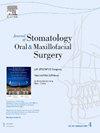垂直脸型对牙槽骨厚度和牙齿形态的影响:基于 CBCT 的回顾性临床研究。
IF 1.8
3区 医学
Q2 DENTISTRY, ORAL SURGERY & MEDICINE
Journal of Stomatology Oral and Maxillofacial Surgery
Pub Date : 2024-10-29
DOI:10.1016/j.jormas.2024.102128
引用次数: 0
摘要
简介:垂直面部形态与牙槽骨和牙齿形态之间的关系对于成功的正畸治疗计划至关重要。本研究旨在评估上颌前牙的垂直面部形态、牙槽骨厚度和根冠尺寸之间的关系:这项回顾性研究筛选了 2022 年 12 月至 2023 年 11 月间正畸患者的 300 张锥束计算机断层扫描(CBCT)扫描图像,其中 115 张符合纳入标准。研究人员测量了颊齿槽骨和舌齿槽骨的厚度以及上颌前牙的牙冠和牙根长度,并根据法兰克福-下颌平面角度对短、正常和长面部类型进行了比较。统计分析采用单因素方差分析、独立样本 Kruskal-Wallis 检验和事后检验:不同脸型的牙槽骨厚度存在显著差异,与正常脸型和长脸型相比,短脸型的腭尖和腭中部的牙槽骨厚度更大(p < 0.05)。不同脸型的牙冠或牙根长度无明显差异:结论:脸型对牙槽骨厚度的影响很大,尤其是短脸型,因为短脸型的牙槽骨支撑力更大。这些发现强调了在正畸治疗计划中考虑脸型以减少并发症的重要性。本文章由计算机程序翻译,如有差异,请以英文原文为准。
Impact of vertical facial type on alveolar bone thickness and tooth morphology: A retrospective CBCT-based clinical study
Introduction
The relationship between vertical facial patterns and the morphology of the alveolar bone and teeth is crucial for successful orthodontic treatment planning. This study aimed to evaluate the relationship between vertical facial patterns, bone thickness, and root-crown dimensions in the maxillary anterior teeth.
Methods
This retrospective study screened 300 cone-beam computed tomography (CBCT) scans of orthodontic patients between December 2022 and November 2023, with 115 meeting the inclusion criteria. Buccal and lingual alveolar bone thickness, along with crown and root lengths of maxillary anterior teeth, were measured and compared across short, normal, and long facial types, classified according to the Frankfort-Mandibular Plane Angle. One-way ANOVA, independent-samples Kruskal-Wallis, and post-hoc tests were used for statistical analysis.
Results
Significant differences in alveolar bone thickness were observed across facial types, with short facial types showing consistently greater thickness in the apical and mid-palatal regions compared to normal and long facial types (p < 0.05). No significant differences in crown or root lengths were found among the facial types.
Conclusion
Facial type significantly influences alveolar bone thickness, particularly in short facial types, which demonstrate greater bone support. These findings underscore the importance of considering facial type in orthodontic treatment planning to minimize complications.
求助全文
通过发布文献求助,成功后即可免费获取论文全文。
去求助
来源期刊

Journal of Stomatology Oral and Maxillofacial Surgery
Surgery, Dentistry, Oral Surgery and Medicine, Otorhinolaryngology and Facial Plastic Surgery
CiteScore
2.30
自引率
9.10%
发文量
0
审稿时长
23 days
 求助内容:
求助内容: 应助结果提醒方式:
应助结果提醒方式:


